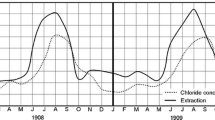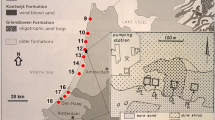Abstract
It has been suggested in a number of historical notes that it was neither Willem Badon Ghijben nor Alexander Herzberg who formulated the famous principle now carrying their name, which relates the water-table elevation to the depth of the freshwater–saltwater interface in coastal aquifers. In this paper, a systematic review of the literature pre-dating the publication of their work is presented. The aim is to establish to what extent these previous works captured the essence of the Ghijben-Herzberg principle, that is, the combination of a correct conceptual model of the hydrogeological conditions with a quantitative relationship. It was found that references to coastal fresh groundwater reserves can be traced back to Roman times, while the earliest detailed descriptions of a freshwater lens that could be found dates from the eighteenth century. The correct understanding of the hydrostatic equilibrium between fresh and salt groundwater is evident in works from the early nineteenth century. However, it was Badon Ghijben and Herzberg who combined this with the correct understanding of the groundwater conditions of a freshwater lens. It was further found that Herzberg had already recorded his findings in 1888 in a hand-written report, confirming speculation that such a report might exist.
Résumé
Dans un certain nombre de notes historiques il a été suggéré que ce n’était ni Willem Badon Ghijben ni Alexander Herzberg qui a formulé le fameux principe qui porte maintenant leur nom, et qui relie l’élévation de la nappe phréatique à la profondeur de l’interface eau douce-eau salée dans les aquifères côtiers. Dans cet article, une revue systématique de la littérature précédant la publication de leurs travaux est présentée. L’objectif est d’établir dans quelle mesure les travaux précédents ont capturé l’essence du principe de Ghijben-Herzberg, c’est-à-dire la combinaison d’un modèle conceptuel correct des conditions hydrogéologiques avec une relation quantitative. On a constaté que les références aux réserves d’eaux douces souterraines côtières remontent à l’époque romaine, tandis que les premières descriptions détaillées d’une lentille d’eau douce qui pourraient être trouvées datent du 18ème siècle. La bonne compréhension de l’équilibre hydrostatique entre l’eau douce souterraine et l’eau salées est évidente dans les travaux du début du 19ème siècle. Cependant, ce sont Badon Ghijben et Herzberg qui l’ont combinée avec la bonne compréhension des conditions hydrogéologiques d’une lentille d’eau douce. Il a également été constaté que Herzberg avait déjà consigné ses conclusions en 1888 dans un manuscrit, confirmant la spéculation qu’un tel. rapport pourrait exister.
Resumen
Se ha sugerido en varias notas históricas que ni Willem Badon Ghijben ni Alexander Herzberg formularon el famoso principio que ahora lleva su nombre, que relaciona la elevación de la capa freática con la profundidad de la interfaz agua dulce-agua salada en los acuíferos costeros. En este trabajo, se presenta una revisión sistemática de la literatura previa a la publicación. El objetivo es establecer en qué medida los trabajos anteriores captaron la esencia del principio Ghijben-Herzberg, es decir, la combinación de un modelo conceptual correcto de las condiciones hidrogeológicas con una relación cuantitativa. Se encontró que las referencias a las reservas costeras de agua dulce se remontan a la época romana, mientras que las primeras descripciones detalladas de una lente de agua dulce que se pueden encontrar datan del siglo XVIII. La comprensión correcta del equilibrio hidrostático entre el agua subterránea dulce y salada es evidente en las obras de principios del siglo XIX. Sin embargo, fue Badon Ghijben y Herzberg quienes combinaron esto con la comprensión correcta de las condiciones del agua subterránea de una lente de agua dulce. Se descubrió además que Herzberg ya había registrado sus hallazgos en 1888 en un informe escrito a mano, lo que confirma la especulación de que tal informe podría existir.
摘要
在众多的历史记录中都显示,既不是Willem Badon Ghijben也不是Alexander Herzberg制定的现在冠以他们名字的著名原理,这个原理就是在沿海含水层中把水位高程与咸水-淡水界面的深度联系在一起。本文系统地论述了他们研究工作之前的文献。目的就是弄清楚这些先前的工作掌握Ghijben-Herzberg原理的精髓到了什么程度,即正确的水文地质条件概念模型与定量相互关系结合到了什么程度。发现,沿海淡水地下水储量的参考信息科追溯到罗马时代,而可找到的最早详细的淡水透镜体描述始于18世纪。正确认识淡水和咸水之间的水静态平衡在19世纪早期的文献中就可见一斑。然而,把这个与正确认识淡水透镜体的地下水条件的是Badon Ghijben和 Herzberg。进一步发现,Herzberg在1888年的手写稿中早已记录了发的发现,推测确认这样的报告可能存在。
Resumo
Tem sido sugerido em diversas notas históricas que não foram nem Willem Badon Ghijben nem Alexander Herzberg quem formulou o famoso princípio que atualmente toma os seus nomes, o qual relaciona a posição altimétrica da superfície livre com a profundidade da interface água doce ̶ água salgada em aquíferos costeiros. Apresenta-se neste artigo uma revisão sistemática da literatura anterior à data da publicação do seu trabalho. O objetivo é estabelecer em que medida esses trabalhos anteriores capturaram a essência do princípio de Ghijben-Herzberg, ou seja, a combinação de um modelo conceitual correto das condições hidrogeológicas com uma relação quantitativa. Descobriu-se que as referências às reservas costeiras de águas doces subterrâneas podem ser rastreadas até ao período Romano, enquanto que as primeiras descrições detalhadas de uma lente de água doce que poderia ser encontrada datam do século XVIII. A compreensão correta do equilíbrio hidrostático entre a água subterrânea doce e a salgada é evidente em obras do início do século XIX. No entanto, foi Badon Ghijben e Herzberg quem combinou isso com o correto entendimento das condições da água subterrânea numa lente de água doce. Verificou-se ainda que Herzberg já havia registrado suas descobertas em 1888 em um relatório escrito à mão, confirmando especulações de que tal relatório poderia existir.



Similar content being viewed by others
References
Anonymous (1890) Norderney (Wasserversorgung und Kanalisation) [Norderney (water supply and sewerage)]. J Gasbeleucht Wasserversorg XXXIII(13):252–253
Bischof G (1847) Lehrbuch der chemischen und physikalischen geologie [Textbook on chemical and physical geology]. Adolph Marcus, Bonn, Germany
Boblaye M (1833) Des depots Terrestres ou Epigeiques a la surface de la Moree [On the terrestrial and epigeic deposits on the surface of Morea]. Annales des mines - Troisieme Serie IV(41):99–126
Bostock J, Riley HT (1893) The natural history of Pliny, vol I. Bell, London
Brutsaert W (2005) Hydrology: an introduction. Cambridge University Press, Cambridge, UK
Carlston CW (1963) An early American statement of the Badon Ghyben-Herzberg principle of static fresh-water–salt-water balance. Am J Sci 261(1):88–91. https://doi.org/10.2475/ajs.261.1.88
Conrad JFW (1881) In: Vergadering van den 12den april 1881, in het lokaal Diligentia, te ’s Gravenhage [Meeting on the 12th of April 1881, meeting hall Diligentia, ’s Gravenhage]. General report of the activities and minutes of the meetings. Tijdschrift van het Koninklijk Instituut van Ingenieurs, Notulen Instituutsjaar 1880/1881:73
Davis SN (1978) Floatation of fresh water on sea water: a historical note. Ground Water 16(6):444–445. https://doi.org/10.1111/j.1745-6584.1978.tb03260.x
De Vries JJ (1994) Willem Badon Ghijben and Johan M.K. Pennink: pioneers of Dutch coastal-dune hydrology. Appl Hydrogeol 4:55–57
Diels H (1891) Über die Genfer Fragmente des Xenophanes und Hippon [About the Geneva fragments of Xenophanes and Hippon]. Sitzungsberichte der königlich Preussischen Akademie der Wissenschaften zu Berlin XXVIII(2):575–586
Drabbe J, Badon Ghijben W (1889) Nota in verband met de voorgenomen putboring nabij Amsterdam [Note concerning the intended well drilling near Amsterdam]. Tijdschrift van het Koninklijk Instituut van Ingenieurs. Verhandelingen, Instituutsjaar 1888/1889:8–22
Du Commun J (1828) On the cause of fresh water springs, fountains, &c. Am J Sci 14(1):174–176
Herzberg A (1888) Erläuterungs-Bericht zum Entwässerungs- und Wasserversorgungs-Projekt des Inseldorfes Nordeney [Explanatory report on the dewatering and water supply project of the island village Norderney]. NLA AU Rep. 16/3, no. 1212, Niedersächsisches Landesarchiv Aurich, Aurich, Germany
Herzberg A (1901) Die Wasserversorgung einiger Nordseebäder [The water supply of some North Sea spas]. J Gasbeleucht Wasserversorg XLIV(44):815–819, 842–844
Houben GJ (2018) Annotated translation of “die Wasserversorgung einiger Nordseebäder [The water supply of some North Sea spas]” by Alexander Herzberg (1901). Hydrogeol J. https://doi.org/10.1007/s10040-018-1772-8
Inglis G (1817) On the cause of ebbing and flowing springs. Philo Mag J L:81–83
Jacob CE (1940) On the flow of water in an elastic artesian aquifer. Trans Am Geophys Union 21:574–586
Johnson CF (1872) Lucretius on the nature of things. Lent, New York, 344 pp
Keilhack K (1912) Lehrbuch der Grundwasser- und Quellenkunde [Textbook of groundwater and spring science], 1st edn. Borntraeger, Berlin
Keilhack K (1917) Lehrbuch der Grundwasser- und Quellenkunde für Geologen, Hydrologen, Bohrunternehmer, Brunnenbauer, Bergleute, Bauingenieure und Hygieniker [Textbook of groundwater and spring science for geologists, hydrologists, drilling contractors, well builders, miners, civil engineers, and hygienists]. Borntraeger, Berlin
Labat J-B (1724) Nouveau voyage aux isles de l’Amérique [New voyage to the islands of America], vol 2, The Hague, The Netherlands. Husson, Paris
le Francq van Berkhey J (1769–1771) Natuurlyke historie van Holland, deel 2 [Natural history of Holland, part 2]. Yntema en Tieboel, Amsterdam
Lulofs J (1750) Inleiding tot eene natuur - en wiskundige Beschouwinge des Aardkloots [Introduction to a physical and mathematical examination of the earth]. Verbeek, Leiden, The Netherlands
Mather JD (2012) Water supply to Britain’s eastern coastal defences in the 18th century and the work of Sir Thomas Hyde Page (1746–1821). Geol Soc Lond Spec Publ 362(1):35–48. https://doi.org/10.1144/sp362.3
Page TH (1784) Descriptions of the King’s wells at Sheerness, Languard-Fort, and Harwich. Phil Trans R Soc Lond 74:6–19
Palmer H (1957) Origin and diffusion of the Herzberg principle with especial reference to Hawaii. Pacific Science XI:181–189
Pennink JMK (1904) De prise d’Eau der Amsterdamsche Duinwaterleiding [The water capture of the Amsterdam dune water supply]. De Ingenieur 19(13):213–223
Post VEA (2018) Annotated translation of “Nota in verband met de voorgenomen putboring nabij Amsterdam [Note concerning the intended well drilling near Amsterdam]” by J. Drabbe and W. Badon Ghijben (1889). Hydrogeol J. https://doi.org/10.1007/s10040-018-1797-z
Ribbius CPE (1903) De duinwatertbeorle in verband met de verdeeling van het zoete en zoute water in den ondergrond onzer zeedulnen [The dune water theory in relation to the distribution of the fresh and saline water in the subsurface of our sea dunes]. De Ingenieur 18(15):244–248
Steggewentz JH (1933) De invloed van de getijdebeweging van zeeën en getijrivieren op de stijghoogte van grondwater [The influence of tidal movement of seas and tidal rivers on the hydraulic head of groundwater]. Technische Hoogeschool, Delft, The Netherlands, 127 pp
Storer J (1815) On an ebbing and flowing stream discovered by boring in the harbour of Bridlington. Philos Mag J XLV:432–436
Storer J (1817) On ebbing and flowing springs: with geological remarks and queries. Philos Mag J L:267–269
Way AG (1955) Caesar the Alexandrian war, African war, Spanish war. Loeb Classical Library. Harvard University Press, Cambridge, MA, 402 pp
Wentworth CK (1951) Geology and ground-water resources of the Honolulu-Pearl Harbor area Oahu, Hawaii. FAO, Rome
Author information
Authors and Affiliations
Corresponding author
Additional information
This article is part of the topical collection “Celebrating 50 years of SWIMs (Salt Water Intrusion Meetings)”
Rights and permissions
About this article
Cite this article
Post, V.E.A., Houben, G.J. & van Engelen, J. What is the Ghijben-Herzberg principle and who formulated it?. Hydrogeol J 26, 1801–1807 (2018). https://doi.org/10.1007/s10040-018-1796-0
Received:
Accepted:
Published:
Issue Date:
DOI: https://doi.org/10.1007/s10040-018-1796-0




